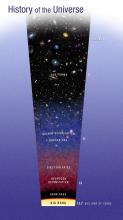Listen to today's episode of StarDate on the web the same day it airs in high-quality streaming audio without any extra ads or announcements. Choose a $8 one-month pass, or listen every day for a year for just $30.
You are here
Cosmic Puzzle
Cosmologists have a puzzle to work on. Their measurements and models of how the universe is expanding don’t match up. That suggests either that something is wrong with the models or observations, or that something is happening in the universe that we don’t know about.
In a recent study, scientists used Hubble Space Telescope to observe exploding stars in many galaxies. The stars brighten and fade in a way that reveals their true brightness. From that, astronomers can calculate how far they are. They also measure how fast the stars and their host galaxies are moving relative to Earth. They then use those numbers to calculate how fast the universe is expanding.
The new study came in at the upper end of the range of results using other techniques. Those techniques have studied exploding stars; old, bloated stars; and stars that pulse in and out. Astronomers also use measurements of the “afterglow” of the Big Bang. The results vary by about 10 percent.
And that makes a big difference. The numbers are critical to our knowledge of when the universe was born, how it’s evolved, and its fate. So a 10 percent range really gums things up.
The difference could mean some of the observations or the models are off. It also could mean that we don’t fully understand the effects of dark energy or dark matter. It could even mean that there are forces or forms of matter awaiting discovery — parts of the complex puzzle of our expanding universe.
Script by Damond Benningfield



